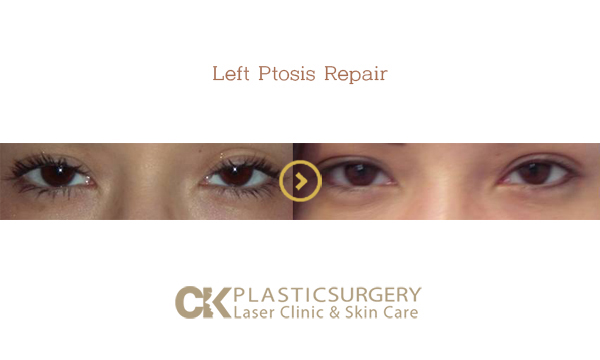Ptosis Correction
Ptosis, also known as droopy eyelid, refers to a condition where the upper eyelid droops or falls lower than its normal position. It can occur due to various factors, such as age, genetics, muscle weakness, or nerve damage. Ptosis can affect one or both eyes, and in some cases, it can obstruct vision and lead to eye strain or fatigue. Ptosis can impact a person's self-confidence and may affect their overall facial appearance.
What is Ptosis Correction?
Ptosis correction is a medical procedure aimed at correcting ptosis, a condition characterized by the drooping or sagging of an anatomical part, most commonly referring to drooping of the upper eyelid. Ptosis of the upper eyelid can be caused by various factors, including congenital (present at birth) or acquired (developed later in life) conditions. It can affect one or both eyes and may lead to impaired vision, discomfort, or an aesthetically displeasing appearance.
Ptosis correction
Features & Benefits
Improved Vision
One of the primary reasons for undergoing ptosis correction surgery is to improve vision. When the upper eyelid droops excessively, it can obstruct the visual field and lead to reduced peripheral vision and even central vision impairment. Ptosis correction lifts the eyelid to a more appropriate position, allowing for clearer and unobstructed vision.
Enhanced Aesthetic Appearance
Ptosis can give the appearance of tiredness, sleepiness, or even asymmetry between the eyes. Ptosis correction surgery can improve the overall aesthetics of the eyes and face. By restoring a more youthful and alert look, the surgery can boost self-confidence and contribute to a more balanced facial appearance.
Reduced Eye Strain and Discomfort
When the eyelid droops significantly, individuals may compensate by raising their eyebrows or straining their forehead muscles to lift the eyelid and improve vision. This can lead to discomfort, headaches, and eye strain. Ptosis correction surgery relieves these symptoms by restoring the eyelid’s normal position and reducing the need for compensatory efforts.
Customized Treatment
Ptosis correction surgery is tailored to each individual’s unique needs. The surgical technique is chosen based on the cause and severity of the ptosis, as well as the patient’s specific anatomy. This personalized approach ensures that the surgical outcome aligns with the patient’s goals and expectations.
ptosis correction
FAQs
For more questions or information please contact us at (213) 382-4900.
What is ptosis?
Ptosis is a condition characterized by drooping or sagging of the upper eyelid. It can affect one or both eyes and can vary in severity. Ptosis may be present from birth (congenital ptosis) or develop later in life due to aging, injury, muscle weakness, or other underlying causes.
What is ptosis correction?
Ptosis correction refers to surgical procedures aimed at correcting the drooping or sagging of the upper eyelid. The specific technique used depends on the severity and underlying cause of the ptosis. Ptosis correction surgery typically involves tightening or repositioning the muscles that control eyelid movement to restore a more natural eyelid position.
Who is a good candidate for ptosis correction surgery?
Good candidates for ptosis correction surgery are individuals who have significant drooping of the upper eyelids that obstructs vision or affects their appearance. It is important to have a consultation with an oculoplastic surgeon or an ophthalmologist specializing in ptosis to determine if you are a suitable candidate for the procedure.
How is ptosis correction surgery performed?
Ptosis correction surgery is typically performed on an outpatient basis under local anesthesia with sedation. The surgeon will make incisions in the natural creases of the eyelids and adjust the muscles responsible for lifting the eyelids. In some cases, excess eyelid skin or fat may also be removed. The specific surgical technique used depends on the severity of the ptosis and the individual patient’s needs.
What is the recovery process like after ptosis correction surgery?
After ptosis correction surgery, patients may experience mild swelling, bruising, and discomfort around the surgical site. Eye drops and ointments may be prescribed to aid in healing and prevent infection. It is important to follow the surgeon’s post-operative instructions, which may include applying cold compresses, keeping the head elevated, and avoiding strenuous activities. Most individuals can resume normal activities, including wearing contact lenses and applying makeup, within a couple of weeks.
Are there any risks or complications associated with ptosis correction surgery?
Ptosis correction surgery is generally safe, but as with any surgical procedure, there are potential risks and complications. These can include infection, bleeding, asymmetry, scarring, dry eyes, changes in eyelid contour, difficulty closing the eyes fully, or changes in vision. It is important to discuss these potential risks with your surgeon and follow their pre- and post-operative instructions to minimize complications.
Will ptosis correction surgery leave visible scars?
The incisions made during ptosis correction surgery are typically placed within the natural creases of the eyelids, aiming to minimize visible scarring. Over time, the scars tend to fade and become less noticeable. However, individual healing and scarring can vary, and some patients may have more noticeable scars. Proper wound care and following the surgeon’s post-operative instructions can help optimize scar healing.
Can ptosis recur after surgery?
In some cases, ptosis can recur after surgery. The risk of recurrence depends on various factors, including the severity of the initial ptosis, underlying causes, and surgical technique used. It is important to have realistic expectations and understand that additional procedures or adjustments may be needed in the future.
Appointment
Want to make booking or have a question?
Call us on 213-382-4900 or simply book an appointment



